
Colorado River Storage Project
Encyclopedia
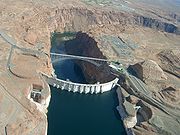
United States
The United States of America is a federal constitutional republic comprising fifty states and a federal district...
Bureau of Reclamation
United States Bureau of Reclamation
The United States Bureau of Reclamation , and formerly the United States Reclamation Service , is an agency under the U.S...
project designed to oversee the development of the upper Colorado River
Colorado River
The Colorado River , is a river in the Southwestern United States and northwestern Mexico, approximately long, draining a part of the arid regions on the western slope of the Rocky Mountains. The watershed of the Colorado River covers in parts of seven U.S. states and two Mexican states...
basin
Colorado drainage basins
The U.S State of Colorado includes the headwaters of several important rivers. The state is divided generally East to West by the Continental Divide. East of the Continental Divide, surface waters flow via the North Platte River, the South Platte River, the Republican River, the Arkansas River,...
. The project provides hydroelectric power
Hydroelectricity
Hydroelectricity is the term referring to electricity generated by hydropower; the production of electrical power through the use of the gravitational force of falling or flowing water. It is the most widely used form of renewable energy...
, flood control and water storage for participating states along the upper portion of the Colorado River and its major tributaries.
Since its inception in 1956, the project has grown to include the participation of several related water management projects throughout the river's basin. The project's original scope, and primary focus, are the upper Colorado River itself, the Green River
Green River (Utah)
The Green River, located in the western United States, is the chief tributary of the Colorado River. The watershed of the river, known as the Green River Basin, covers parts of Wyoming, Utah, and Colorado. The Green River is long, beginning in the Wind River Mountains of Wyoming and flowing...
, the San Juan River, and the Gunnison River
Gunnison River
The Gunnison River is a tributary of the Colorado River, long, in the Southwest state of Colorado. It is the fifth largest tributary of the Colorado River, with a mean flow of 4320 ft³/s .-Description:...
.
Participating states are Arizona
Arizona
Arizona ; is a state located in the southwestern region of the United States. It is also part of the western United States and the mountain west. The capital and largest city is Phoenix...
, Utah
Utah
Utah is a state in the Western United States. It was the 45th state to join the Union, on January 4, 1896. Approximately 80% of Utah's 2,763,885 people live along the Wasatch Front, centering on Salt Lake City. This leaves vast expanses of the state nearly uninhabited, making the population the...
, New Mexico
New Mexico
New Mexico is a state located in the southwest and western regions of the United States. New Mexico is also usually considered one of the Mountain States. With a population density of 16 per square mile, New Mexico is the sixth-most sparsely inhabited U.S...
, Colorado
Colorado
Colorado is a U.S. state that encompasses much of the Rocky Mountains as well as the northeastern portion of the Colorado Plateau and the western edge of the Great Plains...
and Wyoming
Wyoming
Wyoming is a state in the mountain region of the Western United States. The western two thirds of the state is covered mostly with the mountain ranges and rangelands in the foothills of the Eastern Rocky Mountains, while the eastern third of the state is high elevation prairie known as the High...
.
History
Attempts at managing the water supply in the upper Colorado River basin were first recorded in 1854 at Fort Supply in Wyoming, when water was diverted from Blacks ForkBlacks Fork
Blacks Fork is a tributary of the Green River in Utah and Wyoming. The river rises on the northern side of the Uinta Mountains as the combination of three streams draining the area around Tokewanna Peak near the Utah-Wyoming border...
to irrigate local lands. Subsequent diversions of the waters in the Colorado basin led to preliminary investigations of means to develop the system as early as 1902 when the Bureau of Reclamation, then known as the Reclamation Service, was established.
Serious consideration for the project began when the Colorado River Compact
Colorado River Compact
The Colorado River Compact is a 1922 agreement among seven U.S. states in the basin of the Colorado River in the American Southwest governing the allocation of the water rights to the river's water among the parties of the interstate compact...
was signed in 1922 by the participating states, as well as the lower Colorado River states, California
California
California is a state located on the West Coast of the United States. It is by far the most populous U.S. state, and the third-largest by land area...
and Nevada
Nevada
Nevada is a state in the western, mountain west, and southwestern regions of the United States. With an area of and a population of about 2.7 million, it is the 7th-largest and 35th-most populous state. Over two-thirds of Nevada's people live in the Las Vegas metropolitan area, which contains its...
. As a stipulation of that compact, the upper basin states were required to ensure an annual flow of no less than 7500000 acre.ft be delivered to the lower basin states. However, the annual flow of the Colorado River at Lee's Ferry
Lee's Ferry
Lee's Ferry is a site on the Colorado River in Coconino County, Arizona, United States, about 7.5 miles southwest of the town of Page, Arizona and the Glen Canyon Dam, and about 9 mi south of the Utah-Arizona border. It is the former location of a ferry established by John D. Lee, a Mormon...
in Arizona, the established dividing point, were extremely erratic, ranging from 4000000 acre.ft to 22000000 acre.ft. This led to an inability of the upper basin states to meet the minimum delivery requirements to the lower states in dry years, and a loss of significant surpluses in wet years.
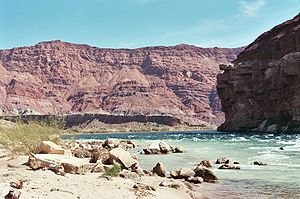
United States Congress
The United States Congress is the bicameral legislature of the federal government of the United States, consisting of the Senate and the House of Representatives. The Congress meets in the United States Capitol in Washington, D.C....
in 1950.
Among the proposed projects was a dam to be constructed on the Green River in Echo Park
Echo Park (Colorado)
Echo Park is a remote river bottom surrounded by canyon walls on the Green River in Dinosaur National Monument. It was first mapped and given its name by the Powell Geographic Expedition in 1869. A proposed dam at Echo Park turned into a nationwide environmental controversy in the early 1950s...
, in Dinosaur National Monument
Dinosaur National Monument
Dinosaur National Monument is a National Monument located on the southeast flank of the Uinta Mountains on the border between Colorado and Utah at the confluence of the Green and Yampa Rivers. Although most of the monument area is in Moffat County, Colorado, the Dinosaur Quarry is located in Utah...
in Colorado. The proposal created controversy and sparked the ire of Sierra Club
Sierra Club
The Sierra Club is the oldest, largest, and most influential grassroots environmental organization in the United States. It was founded on May 28, 1892, in San Francisco, California, by the conservationist and preservationist John Muir, who became its first president...
director David Brower, who embarked on a national campaign to rescue the park. As part of a compromise, the proposed dam was stricken from the project and replaced with another dam in Glen Canyon
Glen Canyon
Glen Canyon is a canyon that is located in southeastern and south central Utah and northwestern Arizona within the Vermilion Cliffs area. It was carved by the Colorado River....
, Arizona. Brower, who had not personally visited Glen Canyon prior to the compromise, later lamented the deal, describing it as "the worst mistake of his career" and "'the biggest sin I ever committed'".
A revised, and slightly pared down, version of the plan was passed in to law by Congress in 1956. The legislation called for the construction of dam
Dam
A dam is a barrier that impounds water or underground streams. Dams generally serve the primary purpose of retaining water, while other structures such as floodgates or levees are used to manage or prevent water flow into specific land regions. Hydropower and pumped-storage hydroelectricity are...
s, reservoir
Reservoir
A reservoir , artificial lake or dam is used to store water.Reservoirs may be created in river valleys by the construction of a dam or may be built by excavation in the ground or by conventional construction techniques such as brickwork or cast concrete.The term reservoir may also be used to...
s and related works at Curecanti
Curecanti National Recreation Area
Curecanti National Recreation Area, in Colorado, is formed by three reservoirs, named for corresponding dams on the Gunnison River. The national recreation area borders Black Canyon of the Gunnison National Park on the west...
in Colorado, Flaming Gorge
Flaming Gorge Reservoir
Flaming Gorge Reservoir is a reservoir in Wyoming and Utah, on the Green River, created by Flaming Gorge Dam. Construction on the dam began in 1958 and was completed in 1964...
in Wyoming, Navajo in New Mexico and Glen Canyon in Arizona. All but the Navajo project were to include power generation capabilities; the Navajo project was intended as flood control only. Also included in the legislation were several related projects in the Colorado River basin.
Project scope
The Colorado River Storage Project is made up of four separate units, spread along the upper Colorado basin and its major tributaries. Also included are several participating projects located throughout the system.As a whole, the system provides a storage capacity of approximately 34000000 acre.ft of water. This capacity is released to meet the Colorado River Compact's delivery requirements during periods of low flow in the system. Additionally, three of the units provide hydroelectric power to major markets in the southwest.
Lee's Ferry in Arizona serves as the southern boundary point for the project, which encompasses the Colorado River upstream from this point and all tributaries.
Glen Canyon Unit
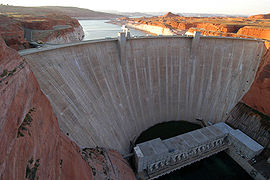
Page, Arizona
Page is a city in Coconino County, Arizona, United States, near the Glen Canyon Dam and Lake Powell. According to 2005 Census Bureau estimates, the population of the city is 6,794.-Geography:Page is located at ....
in northern Arizona, the majority of Lake Powell resides in southern Utah. With a total storage capacity of 27000000 acre.ft of water in Lake Powell, the Glen Canyon Unit accounts for over 64% of the system's overall water storage capacity. The 1,296 megawatt capacity of the dam's hydroelectric generators accounts for almost 75% of the overall generating capacity of the project.
In spite of its importance to the system, the Glen Canyon Unit has also been the source of controversy even before it began operating in 1964. Sierra Club director David Brower, who was partially responsible for the location of the dam as part of a compromise, later regretted the decision. Former Arizona Senator
United States Senate
The United States Senate is the upper house of the bicameral legislature of the United States, and together with the United States House of Representatives comprises the United States Congress. The composition and powers of the Senate are established in Article One of the U.S. Constitution. Each...
Barry Goldwater
Barry Goldwater
Barry Morris Goldwater was a five-term United States Senator from Arizona and the Republican Party's nominee for President in the 1964 election. An articulate and charismatic figure during the first half of the 1960s, he was known as "Mr...
, who was a proponent of the dam in the beginning, later recanted his opinion and admitted that he, too, had regretted supporting the project. Recent calls for the draining of Lake Powell and the restoration of Glen Canyon by environmental groups such as Sierra Club have resulted in the founding of several advocacy groups for the cause such as Living Rivers and Friends of Glen Canyon, as well as opposition groups such as Friends of Lake Powell.
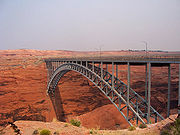
Not directly a part of the project but built as a direct result of it, the Glen Canyon Dam Bridge
Glen Canyon Dam Bridge
The Glen Canyon Bridge or Glen Canyon Dam Bridge is a steel arch bridge in Coconino County, Arizona, carrying U.S. Route 89 across the Colorado River. The bridge was originally built by the U.S. Bureau of Reclamation to facilitate transportation of materials for the Glen Canyon Dam, which lies...
was constructed over the river in 1959. At the time of its completion it was the highest arch bridge
Bridge
A bridge is a structure built to span physical obstacles such as a body of water, valley, or road, for the purpose of providing passage over the obstacle...
in the world. It currently serves as one of only two bridges to cross the Colorado River between Lake Mead
Lake Mead
Lake Mead is the largest reservoir in the United States. It is located on the Colorado River about southeast of Las Vegas, Nevada, in the states of Nevada and Arizona. Formed by water impounded by the Hoover Dam, it extends behind the dam, holding approximately of water.-History:The lake was...
and Lake Powell, carrying the majority of the traffic between northern Arizona and southern Utah.
Flaming Gorge Unit
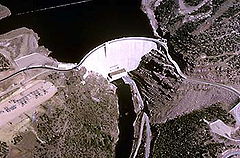
Green River, Wyoming
Green River is a city in and the county seat of Sweetwater County, Wyoming, United States, in the southwestern part of the state. The population was 11,808 at the 2000 census....
, Wyoming. Portions of the reservoir spill over into northeastern Utah.
Completed in 1964, the dam provides water storage and hydroelectric generation, as well as flood control on the Green River, the primary tributary to the Colorado. The powerplant in the dam has a capacity of 153 megawatts or about 8.5% of the entire system.
Navajo Unit
The Navajo Unit consists of the Navajo DamNavajo Dam
Navajo Dam is an earthen dam on the San Juan River, a tributary of the Colorado River, in northwestern New Mexico in the United States. The dam and its reservoir, Navajo Lake, lie in the arid western foothills of the Rocky Mountains about east of Farmington....
and the Navajo Reservoir. The dam impounds the San Juan River near Farmington
Farmington, New Mexico
Farmington is a city in San Juan County in the U.S. state of New Mexico. As of the 2010 U.S. Census the city had a total population of 45,877 people. Farmington makes up one of the four Metropolitan Statistical Areas in New Mexico. The U.S...
, New Mexico.
The dam was completed in 1963, and was actually the first of the units in the project to be completed. Unlike the subsequent dams, Navajo Dam did not have any power generating capacity when built. A small plant with a capacity of 32 MW was installed in 1983 in conjunction with the city of Farmington to generate local power.
Aspinall Unit
The Aspinall Unit consists of 3 dams and reservoirs on the Gunnison River in Colorado. It is the only unit in the project to be made up of more than one dam or reservoir.The Aspinall Unit was originally named the Curecanti Unit, but was renamed for former congressman Wayne N. Aspinall
Wayne N. Aspinall
Wayne Norviel Aspinall was a lawyer and politician from Colorado. He is largely known for his tenure in the United States House of Representatives, serving as a Democrat from 1949-1973 from Colorado’s Fourth District. Aspinall became known for his direction of the House Interior and Insular...
in 1980. Aspinall had been a strong proponent of water reclamation projects in Colorado and the western US in general, and was seen as a key opponent to David Brower in the fight to enact the Colorado River Storage Project. Brower was known to have fought regularly with Aspinall, going so far as to state that he had seen "dream after dream dashed on the stony continents of Wayne Aspinall."
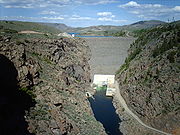
Blue Mesa Dam
The Blue Mesa Dam impounds the Gunnison River upstream of the Morrow Point Dam, making it the first dam the river passes through. The dam was completed in 1966 and has an electric generating capacity of 86,400 kilowatts, or about 30% of the Aspinall Unit's generating capacity.Morrow Point Dam
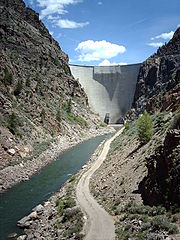
Additionally, the Morrow Point Dam is the first thin-arch concrete dam to be build in the Colorado River Storage Project system.
Crystal Dam
The Crystal Dam impounds the Gunnison River about 6 miles (10 km) downstream from the Morrow Point Dam, making it the final dam in the Aspinall Unit. Completed in 1976, it is the last dam in both the Aspinall Unit and the Colorado River Storage Project to be completed, marking the final completion of the system as a whole.Crystal Dam has the smallest capacity of the hydroelectric dams in the system, providing some 31,500 kilowatts capacity, or just over 1% of the Aspinall Unit's capacity.
Participating projects
A number of water management projects in various locations of the upper Colorado River basin are considered participating projects in the Colorado River Storage Project. These projects are financially related to the CRSP but are not considered a part of the project itself.11 projects were included as participating projects in the 1956 legislation. These projects include:
- Central Utah ProjectCentral Utah ProjectThe Central Utah Project is a United States federal water project. It was authorized for construction under the Colorado River Storage Project Act of April 11, 1956 as a participating project...
, numerous dams and reservoirs in central Utah - Emery County Project, covering dams in Emery CountyEmery County, UtahEmery County is a county located in the U.S. state of Utah. As of 2000 the population was 10,860, and by 2009 had been estimated to decrease to 10,629. It was named for George W. Emery, governor of the Utah Territory in 1875...
, Utah - Florida Project, on the Florida RiverFlorida RiverFlorida River is a tributary of the Animas River in La Plata County, Colorado. The river's source is Lillie Lake in the Weminuche Wilderness. It joins the Animas River south of Durango on the Southern Ute Indian Reservation near the New Mexico state line....
in southwestern Colorado - Hammond Project, on the San Juan River in northeastern New Mexico
- La Barge Project in Wyoming
- Lyman Project, on the Blacks ForkBlacks ForkBlacks Fork is a tributary of the Green River in Utah and Wyoming. The river rises on the northern side of the Uinta Mountains as the combination of three streams draining the area around Tokewanna Peak near the Utah-Wyoming border...
and Smiths Fork of the Green River, primarily in Wyoming - Paonia Project in west-central Colorado
- Pine River Project in western Colorado
- Seedskadee ProjectSeedskadee ProjectThe Seedskadee Project is a water resources development project of the U.S. Bureau of Reclamation. The project focuses on the upper Green River in western Wyoming, storing the river's waters in Fontenelle Reservoir. The project is associated with the Colorado River Storage Project, retaining the...
on the upper Green River Basin in Wyoming - Silt Project in west-central Colorado
- Smith Fork Project in west-central Colorado
Wyoming's Eden Project was authorized independently in 1949. It was tied to the Colorado River Storage Project by the terms of its own authorization.
An amendment to the legislation in 1962 added two projects to the participants list:
- San Juan-Chama Project, diverting water from the San Juan River basin out to the Rio GrandeRio GrandeThe Rio Grande is a river that flows from southwestern Colorado in the United States to the Gulf of Mexico. Along the way it forms part of the Mexico – United States border. Its length varies as its course changes...
basin - Navajo Indian Irrigation ProjectNavajo indian irrigation projectThe Navajo Indian Irrigation Project is a large agricultural development located in the northwest corner of New Mexico. The NIIP is one of the largest Native American owned and operated agricultural businesses in the United States. This venture finds its origins in the 1930s when the federal...
, performed on behalf of the Bureau of Indian AffairsBureau of Indian AffairsThe Bureau of Indian Affairs is an agency of the federal government of the United States within the US Department of the Interior. It is responsible for the administration and management of of land held in trust by the United States for Native Americans in the United States, Native American...
A 1964 amendment added three more projects:
- Bostwick Park Project, involving Cimarron Creek, a tributary of the Gunnison River
- Fruitland Mesa Project in Colorado
- Savery-Pot Hook Project in Colorado and Wyoming
The Colorado River Basin Project Act in 1968 added a final five projects to the participants list:
- Animas-La Plata Project in Colorado and New Mexico
- Dallas Creek Project, a tributary of the Uncompahgre RiverUncompahgre RiverThe Uncompahgre River is a tributary of the Gunnison River, approximately 75 mi long, in southwestern Colorado in the United States. Lake Como at 12,215 ft in northern San Juan County, in the Uncompahgre National Forest in the northwestern San Juan Mountains is the headwaters of the...
, in turn a tributary of the Gunnison River - Dolores Project in southwestern Colorado
- San Miguel Project, Colorado
- West Divide Project, Colorado
Four projects, the Fruitland Mesa, Savery-Pot Hook, San Miguel and West Divide Projects, were later found to be infeasible and removed from the list.
Project impact
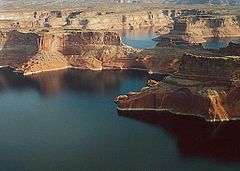
Navajo Generating Station
Navajo Generating Station is a 2250 megawatt coal-fired powerplant located on the Navajo Indian Reservation, near Page, Arizona, USA. This plant provides electrical power to customers in Arizona, Nevada, and California...
.
The Blue Mesa and Navajo Dams, built primarily to function for flood control purposes, have saved approximately $10 million in flood-related costs up to the year 1999.
Additionally, the various units of the project have created significant recreational opportunities throughout the otherwise arid southwest regions.

